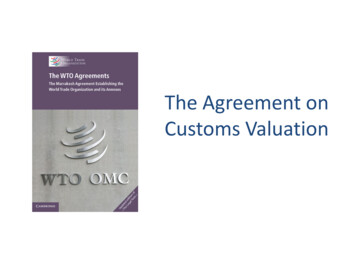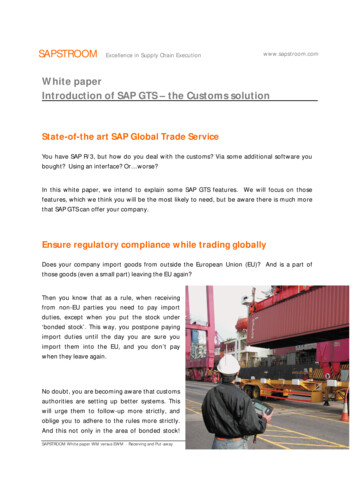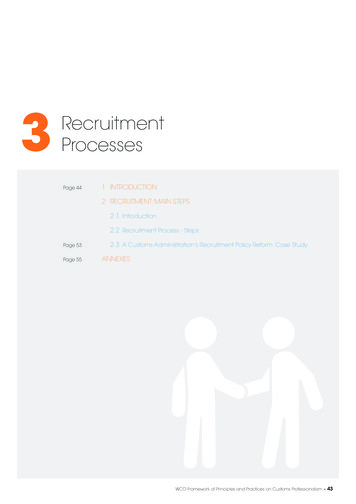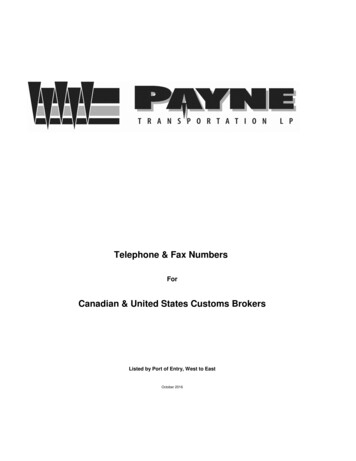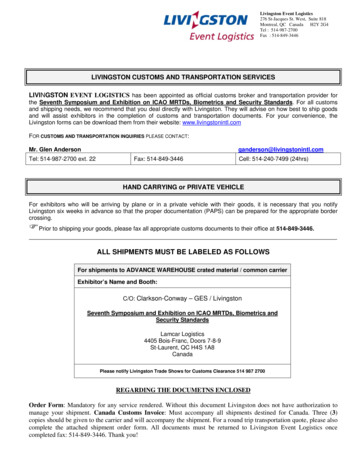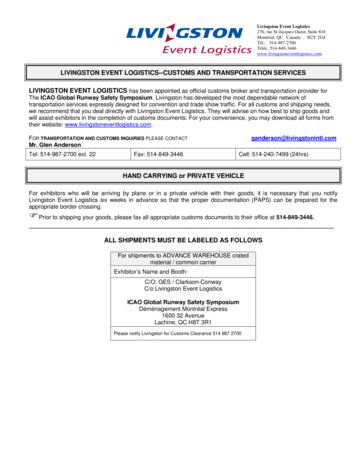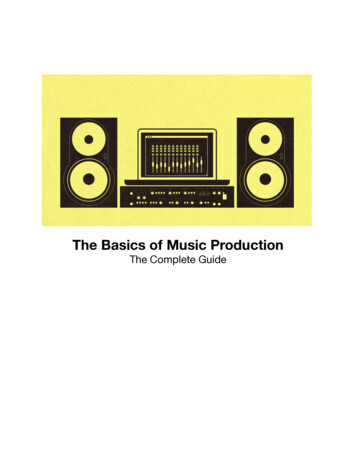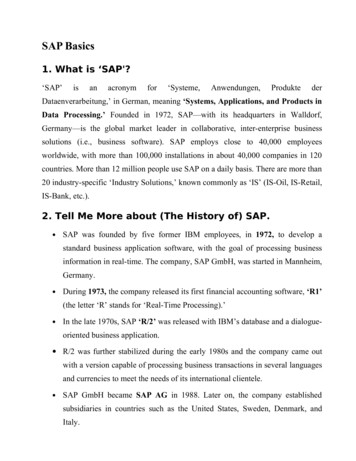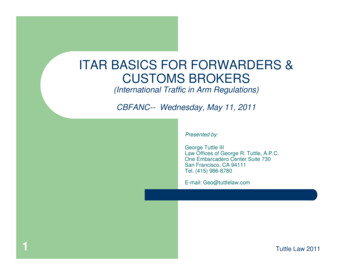
Transcription
ITAR BASICS FOR FORWARDERS &CUSTOMS BROKERS(International Traffic in Arm Regulations)CBFANC-- Wednesday, May 11, 2011Presented by:George Tuttle IIILaw Offices of George R. Tuttle, A.P.C.One Embarcadero Center Suite 730San Francisco, CA 94111Tel. (415) 986-8780E-mail: Geo@tuttlelaw.com.1Tuttle Law 2011
Understanding State/DDTC & the ITAR 2International Traffic in Arms Regulations (ITAR)–Regulates the export and temporary import of defenserelated articles and services on the United StatesMunitions List (USML).–Permanent imports are regulated by the Attorney Generalunder the direction of the Department of Justice's Bureau ofAlcohol, Tobacco, Firearms, and Explosives (see 27 CFRparts 447, 478, 479, and 555)Tuttle Law 2011
3Tuttle Law 2011
Understanding State/DDTC & the ITAR ITAR implements the provisions of the Arms Export Control Act(AECA) (22 U.S.C. § 2778): Scope of AECA–4Authorizes President to: Control the import and the export of defense articles and defense services designate items which shall be considered as defense articles and defenseservices . . . promulgate regulations for the import and export of such articles and services–Governs Arms Sales – Foreign Military Sales and Direct Commercial Sales–Mandates Registration and Licensing of any Person Who Engages in Manufacturing,Exporting or Brokering of Defense Articles and Services–Requires Monitoring/Reporting Fees, Contributions and CommissionsTuttle Law 2011
Understanding State/DDTC & the ITAR Authority to interpret and enforce ITAR is given to thePresident and delegated to the Department of State–ITAR is found in Title 22 (Foreign Relations) Parts 120130State Dept’s Directorate of Defense Trade Controls (DDTC) regulatesexport of articles & technology that are under the Jurisdiction of theInternational Traffic in Arm Regulations (ITAR), including:-- defense articles, including most space related articles-- defense services, and-- related technical data5Tuttle Law 2011
6Tuttle Law 2011
7Tuttle Law 2011
8Tuttle Law 2011
DDTC OrganizationRobert S. Kovac, ActingDeputy Assistant SecretaryDefense TradeRobert S. KovacManaging DirectorDirectorate of Defense Trade ControlsOffice of Defense TradeControls Compliance(PM/DTCC)9Office of Defense TradeControls Licensing(PM/DTCL)Managing Director’s StaffOffice of Defense TradeControls Policy(PM/DTCP)Tuttle Law 2011
Understanding State/DDTC & the ITAR Other Agencies, including:–10Commerce Dept’s Bureau of Industry and Security (BIS) controls items under theJurisdiction of the EAR. Census Bureau, Foreign Trade Division-- compiles and publishes theofficial merchandise trade statistics and regulations governing exportreporting requirements.–Treasury Dept’s Office of Foreign Assets Control (OFAC)oversees embargo and sanction lists – OFAC regulations.–Homeland Security Dept’s U.S. Customs and Border Protectionenforces all exports at U.S. borders.Tuttle Law 2011
11Tuttle Law 2011
Contacts12Tuttle Law 2011
What Is A “Defense Article”? § 120.6 Defense article– Or,–13Defense article means any item or technical data designated in§121.1 [United States Munitions List (USML)].A product that incorporates a part or a component which is itself a“defense article.” (Known as the “see-through rule.” ) (Boeingfined 15 mil for export of QRS-11 navigation sensor incommercial jets to China)Tuttle Law 2011
What Is A “Defense Article”? ITAR controls “defense articles”––14An article is a “defense article” (22 CFR 120.3) if it is: Specifically designed, developed, configured, adapted or modifiedfor a military application [on the USML] Does not have a predominant civil application Does not have performance equivalent (defined by form fit orfunction) to those articles used in civil applicationsIntended end use (civil or military) after export is not relevant indetermining whether item is subject to ITAR controlsTuttle Law 2011
What Is A “Defense Article”? Term “defense articles” includes (22 CFR 120.6)––15Technical data stored or recorded in an physical form, including: Models Mock-ups Other items that reveal technical data directly relating to items onmunitions listDoes not include basic marketing information on functions, purpose,or general systems descriptionsTuttle Law 2011
What Is A “Defense Article”? 16Technical data is defined in 22 CFR 120.10 as Informationrequired for the:–Design, development, production, manufacture, assembly,operation, repair, testing, maintenance or modification of defensearticles.–Includes information in the form of blueprints, drawings,photographs, plans, instructions or documentation.–Software includes but is not limited to the system functional design,logic flow, algorithms, application programs, operating systems andsupport software for design, implementation, test, operation,diagnosis and repair. See 22 CFR 121.8(f)Tuttle Law 2011
What Is Are “Defense services”? 17§ 120.9 Defense services–Furnishing of assistance (including training) to foreign persons,whether in the United States or abroad in the design,development, engineering, manufacture, production, assembly,testing, repair, maintenance, modification, operation,demilitarization, destruction, processing or use of defense articles;–Furnishing to foreign persons of any technical data controlledunder this subchapter (see §120.10), whether in the United Statesor abroad; or–Military training of foreign units and forces,–formal or informal instruction of foreign persons in the UnitedStates or abroadTuttle Law 2011
United States Munitions List (USML) § 121.1 General. The United States MunitionsList.–18Category I—Firearms, Close Assault Weapons and Combat Shotguns (a) Guns under caliber .50 category excludes any non-combat shotgun with a barrel length of 18 inches orlonger, BB, pellet, and muzzle loading (black powder) firearms. Does not cover riflescopes and sighting devices that are not manufactured tomilitary specifications. Excludes accessories and attachments (e.g., belts, slings, after market rubbergrips, cleaning kits) for firearms that do not enhance the usefulness,effectiveness, or capabilities of the firearm, components and parts.Tuttle Law 2011
United States Munitions List (USML)–Category II—Guns and Armament –Category III—Ammunition/Ordnance for the articles in Cat I and II–Category IV—Launch Vehicles, Guided Missiles, Ballistic Missiles,Rockets, Torpedoes, Bombs and Mines–Category V—Explosives and Energetic Materials, Propellants,Incendiary Agents and Their Constituents–Category VI—Vessels of War and Special Naval Equipment.–Category VII—Tanks and Military Vehicles–Category VIII—Aircraft and Associated Equipment 19*(a) Guns over caliber .50§ 121.3 Described Aircraft and related articles covered by Cat VIIITuttle Law 2011
United States Munitions List (USML)–Category IX—Military Training Equipment and Training–Category X—Protective Personnel Equipment and Shelters–Category XI—Military Electronics 20(a) Electronic equipment not included in Category XII of the U.S. Munitions List which isspecifically designed, modified or configured for military application.–Category XII—Fire Control, Range Finder, Optical and Guidance and ControlEquipment–Category XIII—Auxiliary Military Equipment (a) Cameras and specialized processing equipment therefor, (b) Military Information Security Systems and equipment, cryptographic devices, software, andcomponents (c) Self-contained diving and underwater breathing apparatusTuttle Law 2011
United States Munitions List (USML)21–Category XIV—Toxicological Agents, Including Chemical Agents, BiologicalAgents, and Associated Equipment–Category XV—Spacecraft Systems and Associated Equipment *(a) Spacecraft, including communications satellites, remote sensing satellites,scientific satellites, research satellites, navigation satellites, experimental andmulti-mission satellites Includes commercial communications satellites, scientific satellites, researchsatellites and experimental satellites (b) Ground control stations (c) Global Positioning System (GPS) receiving equipmentTuttle Law 2011
United States Munitions List (USML) Category XVI—Nuclear Weapons, Design and Testing Related ItemsCategory XVII—Classified Articles, Technical Data and Defense Services NotOtherwise EnumeratedCategory XVIII—Directed Energy Weapons– Category XIX [Reserved]Category XX—Submersible Vessels, Oceanographic and AssociatedEquipmentCategory XXI—Miscellaneous Articles––22Lasers, Particle beam systems, High power radio-frequency (RF) systems(a) Any article not specifically enumerated in the other categories of the U.S.Munitions List which hassubstantial military applicability and which has been specifically designed, developed,configured, adapted, or modified for military purposesTuttle Law 2011
United States Munitions List (USML) 23Categories generally include:–All components, parts, accessories, attachments and associatedequipment for the articles indentified in the category.–Technical data (as defined in §120.10 of this subchapter) anddefense services (as defined in §120.9 of this subchapter) directlyrelated to the defense articles enumerated in the categoryTuttle Law 2011
§ 121.8 End-items, components, accessories,attachments, parts, firmware, software and systems An end-item is an assembled article ready for its intended use. A component is an item which is useful only when used in conjunctionwith an end-item. 24 A major component includes any assembled element which forms aportion of an end-item without which the end-item is inoperable. A minor component includes any assembled element of a majorcomponent.Accessories and attachments are associated equipment for anycomponent, end-item or system, and which are not necessary fortheir operation, but which enhance their usefulness oreffectiveness. (Examples: Military riflescopes, special paints, etc.)Tuttle Law 2011
§ 121.8 End-items, components, accessories,attachments, parts, firmware, software and systems(d) A part is any single unassembled element of a major or a minorcomponent, accessory, or attachment which is not normallysubject to disassembly without the destruction or theimpairment of design use. (Examples:Rivets, wire, bolts, etc.)(g) A system is a combination of end-items, components, parts,accessories, attachments, firmware or software, specificallydesigned, modified or adapted to operate together to perform aspecialized military function.25Tuttle Law 2011
What Is An “Export”?26 § 120.17 Export. (a) Export means:–(1) Sending or taking a defense article out of the United States inany manner, except by mere travel outside of the United States bya person whose personal knowledge includes technical data; or–(2) Transferring registration, control or ownership to a foreignperson of any aircraft, vessel, or satellite covered by the U.S.Munitions List, whether in the United States or abroad; orTuttle Law 2011
What Is An “Export”? 27§ 120.17 Export, cont.,–(3) Disclosing (including oral or visual disclosure) or transferring inthe United States any defense article to an embassy, any agencyor subdivision of a foreign government (e.g., diplomatic missions);or–(4) Disclosing (including oral or visual disclosure) or transferringtechnical data to a foreign person, whether in the United States orabroad; or–(5) Performing a defense service on behalf of, or for the benefit of,a foreign person, whether in the United States or abroad.Tuttle Law 2011
Temporary imports § 120.18 Temporary import––28Temporary import means bringing into the United States from a foreigncountry any defense article that is to be returned to the country from whichit was shipped or takenAny defense article that is in transit to another foreign destination.Tuttle Law 2011
What Is A “U.S. person”? 29§ 120.15 U.S. Person–U.S. person means a person (as defined in §120.14 of this part) who is alawful permanent resident as defined by 8 U.S.C. 1101(a)(20) or who is aprotected individual as defined by 8 U.S.C. 1324b(a)(3).–Any corporation, business association, partnership, society, trust, or anyother entity, organization or group that is incorporated to do business in theUnited States.–Includes any governmental (federal, state or local) entity.–It does not include any foreign person as defined in §120.16 of this part.Tuttle Law 2011
What is a “Foreign person”? 30§ 120.16 Foreign person.–Foreign person means any natural person who is not a lawfulpermanent resident as defined by 8 U.S.C. 1101(a)(20) or who isnot a protected individual as defined by 8 U.S.C. 1324b(a)(3).–Any foreign corporation, business association, partnership, trust,society or any other entity or group that is not incorporated ororganized to do business in the United States,–International organizations, foreign governments and any agencyor subdivision of foreign governments (e.g., diplomatic missions).Tuttle Law 2011
ITAR and Commerce (EAR)jurisdiction Issues Who has control over the export?–31State or Commence Dept. Of State (office of Defense Trade Controls)controls the export of goods and technology that areidentified on the “munitions control list” and certaincommercial “space related articles.” Department of Commerce (BIS) controls the export ofgoods and technology that are identified on theCommerce Control List (CCL).Tuttle Law 2011
Jurisdiction Issues: Scope Of EAR32Tuttle Law 2011
Jurisdiction Issues: Scope Of EAR33Tuttle Law 2011
Jurisdiction Issues 3422 CFR Sec. 120.4 Relation to Department of Commerceregulations.–If an article or service is placed on the United States Munitions List, itsexport is regulated exclusively by the Department of State.–Exports which are not subject to the controls of [22 CFR] are generallyunder the regulatory jurisdiction of the Department of CommerceITAR controls trumps BIS EAR regulations if article can beclassified under both.Tuttle Law 2011
Jurisdiction Issues: The CJ Process The commodity jurisdic
CUSTOMS BROKERS (International Traffic in Arm Regulations) CBFANC-- Wednesday, May 11, 2011 Presented by: George Tuttle III. Law Offices of George R. Tuttle, A.P.C. One Embarcadero Center Suite 730 . San Francisco, CA 94111. Tel. (415) 986-8780. E-mail: Geo@tuttlelaw.com. 2 Tuttle Law 2011 Understanding State/DDTC & the ITAR Regulates the International Traffic in Arms Regulations (ITAR .

